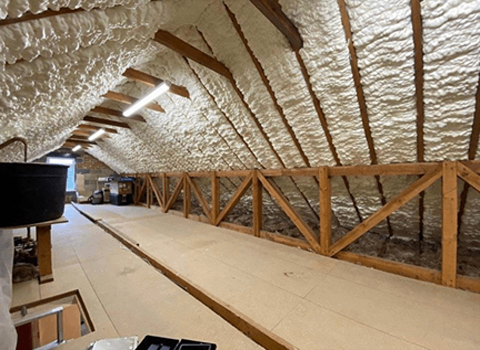When it comes to keeping our homes and commercial buildings energy-efficient, the choice of thermal insulation material can make a significant difference.
Insulation helps to reduce the transfer of heat between the inside and outside of a building, making it more comfortable and energy-efficient.
But with so many insulation materials available in the market, which one is the most efficient?

Spray Foam Insulation Airtight and High Thermal Efficiency
One of the highly regarded thermal insulation materials is fiberglass.
Made from fine glass fibers, fiberglass insulation is widely used in homes and commercial buildings for its excellent thermal performance.
It traps air within its fibers, creating pockets of still air that slow down heat transfer.
This material is also resistant to moisture, which guarantees long-lasting insulation performance.
Fiberglass insulation is relatively easy to install, making it a popular choice among builders and homeowners.
Cellulose Insulation Eco-Friendly and Effective
Another efficient thermal insulation material is cellulose.
Made from recycled paper and treated with flame retardants, cellulose insulation offers exceptional thermal performance.
It is densely packed, reducing the amount of air circulating through the material and thus minimizing heat transfer.
Cellulose insulation can be sprayed or blown into various wall cavities, making it ideal for insulating hard-to-reach areas.
Moreover, it is an eco-friendly option, as it utilizes recycled materials.

Airtight and High Thermal Efficiency
Spray foam insulation is renowned for its high thermal efficiency.
It is made by combining chemicals that react and expand to fill cavities completely.
The resulting foam creates an airtight seal, preventing the leakage of air and heat.
Spray foam insulation has excellent insulating properties, reducing both heat conduction and heat convection.
It is commonly used in new construction or retrofit projects where energy efficiency is a priority.
A relatively newer material in the insulation market is aerogel.
Often referred to as "frozen smoke," aerogel is an extremely lightweight and highly porous substance.
It is composed of a gel-like material where the liquid component is replaced with gas, leaving only the solid structure intact.
Aerogel has exceptional insulating properties, reducing heat transfer through its porous structure.
Although it is more costly compared to other insulation materials, it provides excellent thermal efficiency, making it suitable for specific applications where space is limited.
Mineral wool, commonly known as rock or stone wool, is another contender in the quest for efficient thermal insulation.
It is made by melting a combination of rocks, blast furnace slag, and other recycled materials, and then spinning it into fibers.

Mineral wool insulation has excellent fire resistance and thermal performance.
It is also water repellent and highly durable, ensuring long-lasting insulation in various applications.
Overall, it is difficult to determine a single material as the most efficient thermal insulation.
The choice depends on various factors, such as the specific application, budget, and desired level of insulation.
Each material mentioned above has its strengths and weaknesses, and what works best for one project may not be suitable for another.
In conclusion, there are several thermal insulation materials available in the market, each with its own set of advantages and disadvantages.
Whether it is fiberglass, cellulose, spray foam, aerogel, or mineral wool, the choice ultimately depends on the specific needs and goals of the project.
Consulting with insulation professionals can help in making an informed decision and selecting the most efficient thermal insulation material for any given situation.
It is worth noting that the efficiency of thermal insulation materials is determined by their R-value.
The R-value represents the ability of the material to resist heat transfer.
The higher the R-value, the more effective the insulation material is at reducing heat transfer.
Fiberglass insulation typically has a high R-value, ranging from R-3.2 to R-4.3 per inch of thickness.
This makes it an efficient choice for insulating walls, ceilings, and attics.
Cellulose insulation, on the other hand, has an R-value of approximately R-3.2 to R-3.8 per inch, depending on the density and foam method.
While slightly lower than fiberglass, cellulose insulation still provides excellent thermal performance.
Spray foam insulation stands out with its impressive R-value.
It can have an R-value of R-6 to R-7 per inch, making it highly efficient at reducing heat transfer.
The ability of spray foam to create an airtight seal adds to its effectiveness, minimizing air leakage and further enhancing energy efficiency.
Aerogel insulation is known for its exceptional thermal properties.
It can have an R-value as high as R-10 per inch, making it one of the most efficient insulation materials available.
Its low thermal conductivity and porous structure make aerogel insulation a top choice for applications where space is limited but high thermal efficiency is required.
Mineral wool insulation has varying R-values depending on the type and density of the product.
Dense mineral wool can have an R-value of approximately R-3.0 to R-4.2 per inch, while less dense versions may have lower R-values.
Despite this, mineral wool insulation is still considered efficient and is widely used in commercial and industrial applications.
In conclusion, there is no one-size-fits-all answer to what the most efficient thermal insulation material is.
Different insulation materials have their unique advantages and can be more suitable for specific applications.
Considering factors such as cost, installation method, R-value, and environmental impact can help determine the most efficient thermal insulation material for a particular project.
Consulting with insulation professionals and conducting thorough research will ensure the best choice is made to achieve optimum energy efficiency and comfort in buildings.

